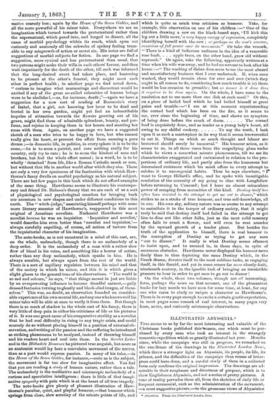ILLUSTRATED ABYSSINIA.* Timis seems to us by far the most
interesting and valuable of the Christmas books published thisoseason, one which must be purchased by every man who took an interest in the strangely romantic expedition which so greatly illustrated last year. Months since, while the campaign was still in progress, we remarked on the excellence of the drawings in the Illustrated London News, which threw a stronger light on Abyssinia, its people, its life, its princes, and the difficulties of the campaign than reams of letterpress could have done, and a careful study of them in a collected form only confirms the original impression. The drawings are admirable in their roughness and directness of purpose, which is to show Englishmen Abyssinia, and not a series of pretty pictures. A tone of reality pervades them all, from the sketches of daily life or frequent ceremonial, such as the administration of the sacrament, —a most suggestive picture,—to the gruesome views of Abyssinian mountains, passes, and ravines. This evident truthfulness is the more remarkable because the scenery in Abyssinia so frequently suggests Gustave Dorii's illustrations to the Inferno. He, no doubt, drew many of his ideas from things he had seen,—the St. Gothard in particular, with its towering rocks fluted into columns by incessant cascades, having clearly made a permanent impression on his mind,—but there is something about Abyssinian scenery as weird as his imagination. Look for an instant at Ililaileea (opposite page 22), the first awful pass surveyed by the Engineers, with its rocks lost in the sky, yet approaching within a few feet, and jutting towards one another as if with the intention of suggesting to the traveller his imminent chance of finding a hideous grave beneath them ; or study that Sooroo defile, with rocks which rise like mountains, yet retain a strange likeness to a vast quarry blasted out by man, and think for a second of the position of those soldiers, the ants creeping along blow, if an Abyssinian Hofer had held the peaks ! " Rayraguddee, below the Senafe Plateau," the deep dell with the mountains showing like castle battlements, is in the very style of Dor6, who would slightly increase the depth, slightly raise the ghostly towers, and make of the place a scene which a child would recognize not to belong to earth. This look of ruined architecture in the Abyssinian rocks reappears in many sketches, notably in one (opposite page 59) of a view near the King's House, Magdala, where the towering natural walls seem the buttresses of some gigantic cathedral piled up before man, and ruined by some flame which also destroyed a world. And even Dord, we think, might learn a lesson in the art of depicting dreariness,—dreariness as distinguished from horror,—from that audacious sketch of the camp at Senafe,—a sketch in which nothing is definite, and little visible except a few hills, looking as
• ant-hills probably look in Jupiter,—yet the spectator feels as if he were actually looking down, expecting the mists to rise from off the silent camp below. There is a look about that sketch as if it had been taken from another planet, as if the odd notion of some photographers, that we might one day by incessant subdivision and enlargement obtain a photograph of a scene upon the moon, had at last been realized. Or stand for a moment before Amba Aladjeh, the stronghold of Weida Yasous, a place to which Ehrenbreitstein is a child's toy, and feel the fatigue the sight of it seems to impress upon your knees. The grandeur of Magdala itself does not come out in these sketches, except partially in the scene where the plateau and the rocks below are lighted up by the blaze of the destroyed fortress ; but there is but a single picture with even an appearance of unreality, the sketch of the battle of Aroghee (opposite page 57), where the treatment of the clouds is Martinesque, and the whole scene somehow recalls Joshua and the moon on Ajalou, and is half Biblical, half operatic. We dare say it is true enough, but in drawing that is true which produces on the spectator the effect of truth.
The scenery of Abyssinia will, we think, most interest our readers,—by the way, did the artist not see one soft scene ?—but the book is full of other sketches, sketches of the people, of the chiefs, of the women, of operations, of incidents like the departure of the released prisoners, all excellently done, though they lack, of course, the strange effect of a scenery so utterly unlike anything the majority of Europeans have ever seen. The best of the figure pieces is decidedly "the administration of the Sacrament" (opposite p. 11), where the priests' faces are like photographs, and the "services on Palm Sunday," a perfect study of Abyssinian physiognomy. There is a small wretch there ringing a bell, a budding priest, we suppose, whose face is a gem, half cherub, half gurgoyle, such as only Mr. Marks could thoroughly do justice to. Of the other scenes, we like best the "Watering Troughs at Zoulla," with its infinity of barely suggested details ; but they are all good with the exception of the "Pier ttt Zoulla," a sketch which may be accurate, and we suppose is accurate, but lacks couleur locale more than any picture we can remember to have seen.
The letterpress is a careful and somewhat minute compilation, giving a very lucid account of Abyssinia and its history, and very full details of the British invasion, but rather deficient both in picturesqueness and simplicity. The work, however, has never before been done, the author has consulted the best authorities, and to all unfamiliar with Mr. Plowden's reports, or the despatches and letters of the campaign, his narrative will increase the interest of the engravings.











































 Previous page
Previous page